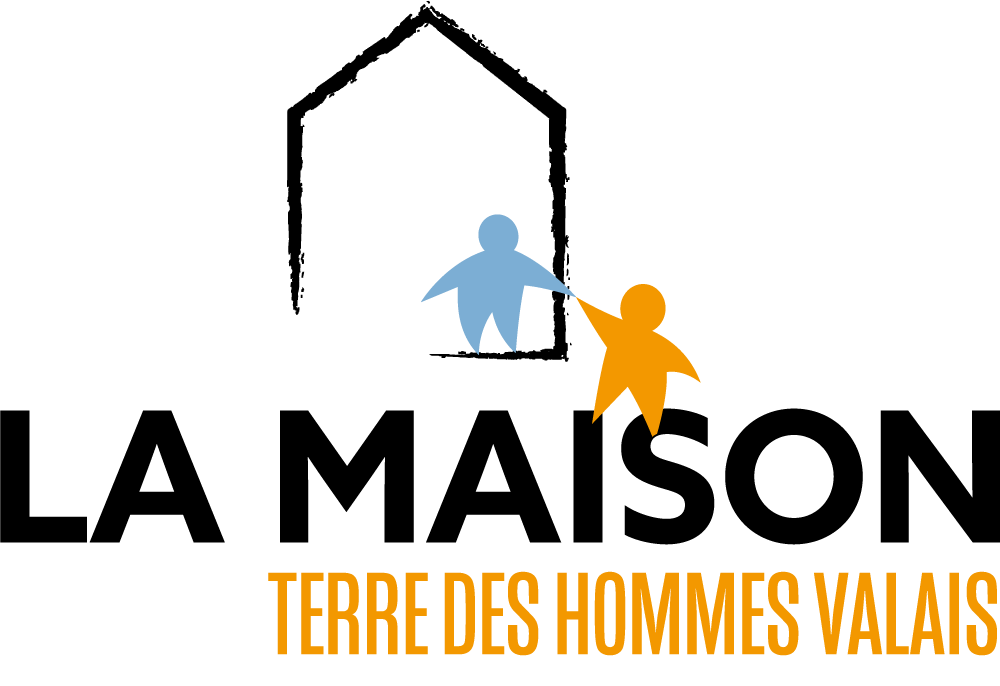Welcoming the little ones: caring professionals
written on the 01.12.2018How are the little ones welcomed in La Maison?
Being professional yet fostering human values. Those are the skills of the professionals doing a quality work over the years with the youngest residents in La Maison. Passion, respect, and trust guide their action until the child goes back to his loved ones.
Mélanie Casanova
Her mission: Give children the medical care they require during their stay
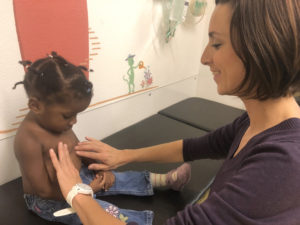
“In my years spent at the intensive paediatric care unit of the CHUV, I often asked myself this question. What happens to the children from Terre des hommes who come to receive medical care alone in Switzerland? I often thought it was slightly “barbaric” to deprive them of their parents, but that was only until I visited La Maison of Terre des hommes. Seeing the children happy, it made sense. I even though I might work there someday. And here I am today.”
From the volunteer driver’s arms to the nursing staff: welcoming the children in La Maison
When a small child arrives in La Maison, he is accompanied by a volunteer driver. The first contact is usually with the nursing staff. Since the departure from their home countries, they have been encountering new people all along the way that have each looked after them. “For a little one, explains Mélanie, the need of physical contact is very strong. From the age of nine months old, the child needs someone they can tie themselves to. Therefore, we try to take on that role and reassure them. Sometimes, opening your arms to them is enough to create a bond. It is a very smooth approach. The rapidity of the transition between the volunteer driver and us depends often on how used the child has been to spend time with people he doesn’t know. It can be very instant, but it can also take some time. The first contact is decisive, and will determine the rest of the child’s stay.”
The same welcome, but different integrations depending on the home country
The culture of the child’s home country is also very important with regards to his behaviour upon arrival in La Maison. Children from Senegal, for instance, will need less time to settle in than the ones from Tunisia. They culturally tend to be more used to being in strangers’ arms. Usually, the little ones adapt very quickly. It makes their hospitalisation easier, but the anxiety and stress of this step remain. “One of the main difficulties for us is maintaining an affective distance adapted to each child. Too much proximity makes the hospitalisation more difficult, and too much distance makes the child more fragile in this event. It’s about finding the right balance.” The group dynamic, the teams intensely work on, is also crucial for everyone’s wellbeing. The children grow together, help each other and are very sensible of the atmosphere in La Maison.
Welcoming the little ones: adapting quickly
All the information regarding the children is provided to partner hospitals to allow the most optimal care. From small habits, to particular needs, to the song that will help them calm down when they are anxious. “During my numerous years in the paediatric unit of the CHUV, I was able to witness how quickly small children adapt in comparison to the older ones who, often, refuse to eat or take their medication. Time seems to pass much more slowly for them. As a mother of a 3-year-old, I am not certain my child, in a similar situation, would adapt this quickly.” Once they have returned home, the children feel an extreme gratitude (depending on their age) and the happiness of their parents knowing they are healed and will keep an imperishable memory of a trip they have returned from, not only healed, but also grown.
Tania Kébé
Her mission: Be a resource person for the child
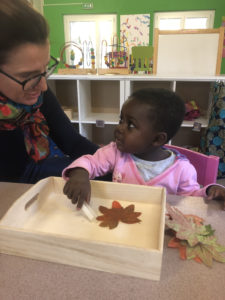
“As a mother myself, I often think of the mothers and the trust they have in us when they entrust their babies to us. Everything I undertake pushes me to stay worthy of that trust.” Tania’s observation meets the one of her colleague Mélanie: the smaller ones adapt quicker than the older children. In less than a week, they have settled in completely and are a part of the community of children in La Maison. “Because they like to be carried, we keep them closer to us. The bigger ones help us when we spend time doing activities altogether. They become an interpreter, either by speech or signs, and act as a precious link.”
The small children entrusted to the bigger ones
A link, between the young child and an older one, which tends to create itself miles away from Massongex at the departure time from their home countries. Indeed, when a mother has to entrust her child to the good care of Switzerland, she often starts by giving the responsibility of her child to an older one who is also engaging in this “trip to life”. A child, usually older, symbolically becomes the new parent of the little one. In these kinds of situations, the children travel together. The older one becomes a point of reference for the younger one, which facilitates the integration in La Maison. There is a clear positive outcome of this relationship in the child’s stay. Settling in is much quicker.
It is the case for Fernandine, 16-year-old, and Atoké, 3-year-old, who arrived together from Benin in August of last year. Fernandine requested to go back to her home country with the little Atoké. “That way, I can hand her back to her mother”, she had said. We must underline the admirable work of mothers in view of the trip. The educating team in La Maison clearly witnesses that children are prepared before their trip. Even the youngest ones understand very well that they are sick, or that something is wrong, even if it might not be noticeable on the outside. When they arrive, they know it is not simple, but that it is a necessary step to get better, and that they are lucky to be here.
Nurturing what is essential for a better welcome and facilitated return
Once they arrive, the team takes over. “I adapt to each child, explains Tania. I carry out a personalised care, from understanding and respecting the behavioural and dietary habits to collecting all the personal information provided by the child’s home country.” The aim is for each child to be able to integrate the community of children as soon as possible and to take part in the activity roll-out throughout the day. “The moments spent with the little ones are very different to the ones spent with the others, older. There is less questioning with small children. In all cases, however, we try to remove all the unnecessary aspects, nurture what is essential, the relationship, the trust, the love and the care.” A behaviour which matters to the residents.
The testimonies of those who have come here are present everywhere in La Maison and remind of the affection and solidarity found here. And it’s important, explains Tania, because “it helps welcoming the children, their stay and their return to the country. It’s important to understand that often, going home does not only mean reuniting with the parents, but also… being confronted to a total destitution.”
Staying worthy of the mothers’ trust in looking after their children
“In certain countries, emergency relief do not exist. Disarmed parents, seeking for vital care for their children, pass on to their sick child, without noticing, a certain stress and worry. Thereafter, the possibility of a transfer as the only way to survive, of course, influences the child. The resilience resulting from it helps with the child’s care in La Maison and the hospitals. Our view here is completely different to the one over there. The comfort and attention a child receives during his stay in a hospital is very high. Even if he could be taken care of in his country, it is very likely that he wouldn’t receive the small stuffed animals and as much attention there.”
Pr Nicole Sekarski-Hunkeler
Her mission: Heal the heart disease of a child
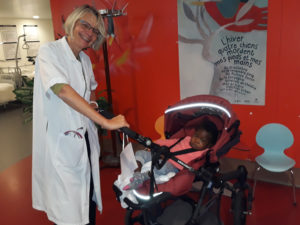
Can you explain the challenges that lie in diagnosing a little one looked after by Terre des hommes?
In Africa, heart malformations are diagnosed long after birth. Often after a few months or years because the access to specialised care is, in most cases, non-existent. Because of the lack of means to treat them, particularly in terms of cardiac paediatric surgery, many children do not survive. Here, these pathologies are often detected before birth or within the first few weeks of life. A rapid care, in the first years of a child’s life, allows a recovery and enables to avoid adverse effects, on the long term, of their non-treated cardiopathy.
Considering your experience, what type of welcome and particular care do the children receive in the hospital?
It is currently unconceivable for the children transferred to Switzerland to be operated in their country. The medical infrastructures and lack of surgical experience for congenital heart malformations onsite do not allow it. Parents trust us and we do our best to help them. The competencies and support surrounding the children is very important. Being hospitalised remains a challenge, it isn’t something enjoyable.
When these children arrive in the hospital, they sometimes are left by themselves. At home, they are always very close to their mother and very often carried. The nurses in the cardiology unit and different paediatric services show a lot of sensitivity in welcoming them. Some of them do not hesitate to carry them on their backs while working. We give them a lot of attention, they are loved by everyone in the service! The doctors and nurses allow more time to see them in order to reassure and play with them. Often, the clinical examination takes place in the nurse’s arms. We make sure that this link, this particular attention, also takes place in other units. When a child isn’t well, we are here to look after him.
For the rest, meaning the medical part, the specialised care is in no way different to the one given to young Swiss patients who also go in the operating room by themselves. Children from Terre des hommes stay together in the same room as often as possible. A team comprised of a cardiologist, a paediatric doctor, nurses and educators works constantly to make sure their stay is as enjoyable as possible. In 2021, the new paediatric hospital dedicated to children will noticeably improve the quality of the care they receive.
After years of practice as a cardiologist, what are your thoughts on the programme of Terre des hommes?
The transfer programme of Terre des hommes is excellent. It enables to offer quality medical care and recovery to children severely ill who wouldn’t have a chance to access it. It opens our eyes and allows us to see the difficulties children face in the world. From a purely medical perspective, the cardiopathies we encounter are often more complex because the child has not been able to access medical care soon enough. The heart has already suffered. This programme enables the whole medical chain to develop specific knowledge. It allows us to improve our competencies in this matter, and, thus, the care given to children from Switzerland as well. There is a real skill transfer from both sides. It is a programme we want to showcase more.
Welcoming children in Switzerland and helping onsite: what are your thoughts on the two parallel actions?
Both actions are complementary to one another. It is fundamental that we continue to travel to these countries to develop heart surgery missions. It enables to reinforce local competencies. With time, children with congenital cardiopathies will be able to be taken care of in their countries. However, we must be realistic. In Switzerland, it took fifty years of heart surgery to get to the excellent level we have today. It will therefore also take years to have a similar level of expertise there. In parallel, it is consequently as essential to be able to continue to give a chance to the powerless children with the most complex malformations here, in Switzerland. For if we were to suspend this action, many children would sadly continue to die in their countries.
What do the children think of La Maison?
The children love La Maison and always talk about it in a very enthusiastic way. For the little ones, it’s not easy to know what they feel sadly, but their smile, when we mention Massongex, helps us guess how much they like it. La Maison, it’s kind of like a big African family. There are children everywhere, the bigger ones look after the younger ones, and it replaces, somewhat, their families for the duration of their stay in Switzerland. It’s reassuring and probably allows the children to forget the difficult times during their transfer. The progress in terms of medical care, the improvements of techniques and the quality of the care the children receive in La Maison contribute to lowering the duration of their stay.
Would you like to invite readers to something specific?
Everyone should at least visit La Maison once. I also invite people to donate, attend the music festival, and engage as a volunteer in order to share the happiness there.
Anne Conne-Borghini
Her mission: Visit the children during their hospitalisation
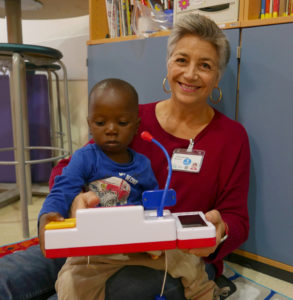
“With the little ones, the contact is physical. We hold their hand, take them in our arms, we need to be tender, affectionate. Take care of them, cuddle them, comfort them, be patient… impossible to replace the parents, but we can give moments of attention and love.
Taking care of the little ones, moments of attention and tenderness
We play, we draw. When it’s possible, we go to the courtyard and play on the swings or go for a walk with the buggy. We take pictures, have ice cream. If they are too tired to go out, we look at images in books, draw, listen to music or play small puzzles. We are very close in those moments. We take them in our arms, sit them on our knees, caress their cheeks or hands… We just spend a moment together, a moment of tenderness and attention.
We are, for these children, referring adults. They turn to us if something went wrong, if they have questions or need anything.
Getting to know each other
With the older ones, we exchange, we talk. We ask them questions about their families, their countries, projects, and we get to know each other. We talk about the differences in our cultures, the relationships between people, between men and women. We talk about politics, we’re never bored! I admire their vitality, their courage and their energy.
In the environment of the hospital, with the gravity and tense moments, I try to give children moments where they can relax, distract them, with a little bit of fantasy, lightness and cheerfulness. Forget, laugh… When I feel I managed to give them that, it makes me really happy!
Often, the children travel with a picture of one or more family members. We pin it to their bed or to the wall in their room. It’s nice to look at the picture with them and point out “mum”, “dad”, to make them understand that we want to nurture their bond with their families. Even if they are far away, they are “here”!
Everyone’s “darlings”
The children of Terre des hommes are particularly pampered by the nursing staff in the hospital. Doctors, nurses, care-takers, teachers, physiotherapists, everyone gives a lot of affection to these children, who are here alone without their parents. They have a special place… They are often in the nurses’ office, on their knees, or in the buggies. They are the “darlings” of the different services of the children’s Hospital!
It’s extraordinary to see how quickly they adapt. After their operation, they develop so fast, it’s wonderful!”
